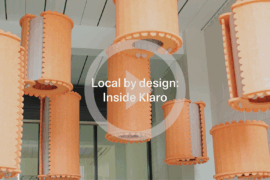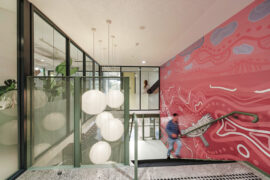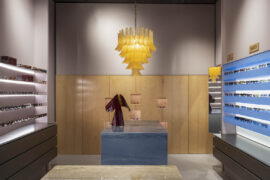Set underground, the latest HARMAY store in Chongqing by AIM Architecture is, to put it mildly, quite astounding. Terracotta red inside and out, the shopping experience is like no other and the interior and exterior design simply enhances the joy of trying and buying.

Harmay, designed by AIM Architecture, photography by Bowen Gu.
October 13th, 2022
In a bold and futuristic design statement, AIM Architecture (AIM) has recently completed a retail store in Chongqing, China for HARMAY, the Chinese beauty giant. As is the way with all of AIM’s projects, the design is definitely out there, creative, original and makes a grand statement for retail design.
Over the past few years AIM has created dozens of individual stores for the HARMAY brand, each is site specific and reflects the history, people and culture of the town or city. In Chongqing, the HARMAY destination evokes ideas of the past cloaked in an innovative and contemporary aesthetic.

Chongqing is a unique city set in mountainous terrain near the Yangtze River. The site for the store is the aged Cathay shopping mall that intertwines with a sloped public plaza.
The interior space is positioned underground but is connected at both ends to the mall. The brief required a new identity for the two façades and to also create a new experiential shopping destination.

Reflecting the history of Chongqing, AIM, with Jerry Guo and Simon Huang as project leads and their team, conceived a large-scale geometric vaulted space that pays homage to the historic air-raid shelters from World War 11, that once connected the entire city underground. The length and shape of the new store resembles a man-made tunnel or cave that relates to the outside world through the showstopping façades at either end.
The new HARMAY store is primarily under ground and lays low in the landscape but makes a bold statement with the deep terracotta coloured exterior. This saturated colour has been continued throughout the interior and maintains continuity, while texture is provided from the rough finished walls.
Related: JMGO flagship store by AIM Architecture

Inspired by the hidden factories in the air raid shelters, AIM has included a giant conveyor belt, generators and other mechanical apparatus as interior furniture, fittings and fixtures and they set the scene for the industrial aesthetic. The belt also acts as a wayfinding device or guide that weaves through the space and shoppers can browse and choose goods to buy as they pass or follow it.
As with every HARMAY store designed by AIM, at the heart of the concept is people and the physical experience. HARMAY Chongqing is not merely a place to purchase cosmetics, it is a space to explore that will provoke an emotional reaction.

AIM Architecture was founded by Belgian and Dutch architects Wendy Saunders and Vincent de Graaf in 2005. The Shanghai-based practice, with an office in Europe, excels in creating design that is unique and unexpected and HARMAY Chongqing is no exception.
Shopping these days is not just about buying – we can all do this online. It is about entering another world that excites and transports us and HARMAY Chongqing certainly elicits reaction, even at first sight. HARMAY Chongqing is another stellar project from AIM and yet another jewel in the design crown of HARMAY.
AIM Architecture was shortlisted in the 2022 INDE.Awards in The Social Space category for Taoxichuan Hotel, in the Unbound Collection by Hyatt.
AIM Architecture
aim-architecture.com
Photography
WenStudio, Bowen Gu






We think you might like this story about AIM Architecture’s porcelain hotel masterpiece.
INDESIGN is on instagram
Follow @indesignlive
A searchable and comprehensive guide for specifying leading products and their suppliers
Keep up to date with the latest and greatest from our industry BFF's!

Sydney’s newest design concept store, HOW WE LIVE, explores the overlap between home and workplace – with a Surry Hills pop-up from Friday 28th November.

In an industry where design intent is often diluted by value management and procurement pressures, Klaro Industrial Design positions manufacturing as a creative ally – allowing commercial interior designers to deliver unique pieces aligned to the project’s original vision.

From radical material reuse to office-to-school transformations, these five projects show how circular thinking is reshaping architecture, interiors and community spaces.

Designed by Woods Bagot, the new fit-out of a major resources company transforms 40,000-square-metres across 19 levels into interconnected villages that celebrate Western Australia’s diverse terrain.

In an industry where design intent is often diluted by value management and procurement pressures, Klaro Industrial Design positions manufacturing as a creative ally – allowing commercial interior designers to deliver unique pieces aligned to the project’s original vision.
The internet never sleeps! Here's the stuff you might have missed

A calm, gallery-like boutique by Brahman Perera for One Point Seven Four brings contemporary luxury and craft to Strand Arcade.

In the New Year, architecture will be defined by its ability to orchestrate relationships between inside and outside, public and private, humans and ecology, and data and intuition.